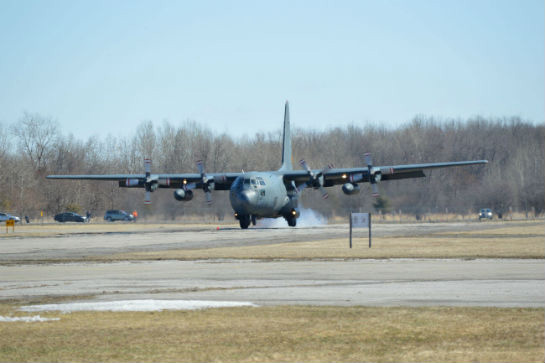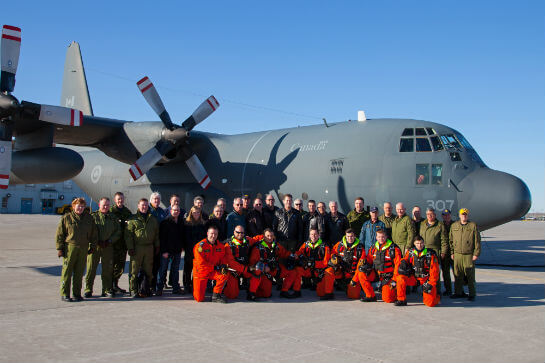Estimated reading time 9 minutes, seconds.

The last Lockheed Martin CC-130E flown by the Royal Canadian Air Force touches down at the Canadian Aviation and Space Museum in Ottawa. Although owned by the museum’s parent Canada Science and Technology Museums Corp., the 3,300-foot runway is managed by the Rockcliffe Flying Club. Ken Pole Photo
On April 5, 2016, the Royal Canadian Air Force (RCAF) retired its final CC-130E Hercules after 51 years of service.
Making the short flight from CFB Trenton, Ont., where it has served for many years, the aircraft arrived at Rockcliffe Airport in Ottawa at its new permanent home, the Canada Aviation and Space Museum (CASM).
The Hercules has served the RCAF since the acquisition of four B model aircraft in 1960. Later sold to the Colombian government in 1969, the success of the B models led to the acquisition of a large fleet of 24 brand new CC-130E models, starting in 1964.
The donated CC-130E has had a long and exemplary career. The longest-serving Hercules in RCAF inventory, it entered service on Feb. 9, 1965. It was one of four CC-130Es that were assigned to 429 Squadron and operated on behalf of Canadian Forces Air Navigation School (CFANS) at CFB Winnipeg, Man. These were converted for the navigation training role in 1975-76 and were officially redesignated as CC-130NTs in 1977. They were equipped with palletized training stations which could be removed for standard cargo operations.
In 1991, the navigation trainers were returned to standard CC-130E configuration. Subsequently, the donated plane served with 435 Transport and Rescue Squadron at Edmonton, and later at 8 Wing Trenton with 424 Transport and Rescue Squadron, 426 Transport Training Squadron, again with 429 Squadron, and also 436 Transport Squadron.
As of May 2015, the donated plane had accumulated almost 47,000 hours of flying time, which is virtually unheard of in the Hercules world. It has had several wing replacements over its career, along with numerous equipment upgrades to keep it up to date.
History in flight
April 5 was a bittersweet day. Chillingly cold for April, a blazing sun lit the ramp at CFB Trenton as a number of dignitaries boarded the aircraft for the short flight to Rockcliffe Airport. RCAF Commander LGen Michael Hood was the senior official aboard. He knows the Hercules well, having once served as commanding officer at 8 Wing Trenton.
After “Tiger 307” took off from Trenton, it climbed to altitude and six 424 Squadron SAR Techs jumped out, parachuting down to land in front of the 424 hangar.
The aircraft then made two spirited “on-the-deck” flypasts before pulling up and heading for Rockcliffe. The flight to its new home at the museum used up almost all of the last two hours of flight time left on the aircraft, for a total of 47,087 flight hours.

A crew of seven 424 Squadron technicians followed the plane to Rockcliffe in order to prepare the aircraft for permanent exhibition. With a “harvest list” of components in hand, the crew was tasked with removing and replacing numerous still serviceable parts of the aircraft with older, time-expired parts, including the engines, propellers, radio and radar.
These parts would be returned to inventory for future use in the RCAF’s remaining legacy H-model Hercules. This operation was slated to take about a week.
The donated Hercules was the last one in the fleet still equipped with the old steam gauges.
“The H-model legacy Hercules has recently been upgraded with a new glass cockpit that is night vision goggle [NVG] capable,” explained LCol Dan Poitras, commanding officer of 424 Squadron. “This was previously only available on the new CC-130J Hercules fleet. The legacy Hercs will continue to provide a good stepping stone for the J model, and the new NVG capability is a boon to search-and-rescue operations, one of the legacy Hercules’ primary roles.”
The arrival
Within minutes of landing at CASM, the Herc was taxied up to the museum’s main building for a brief handover ceremony.
Hood, the RCAF’s commander since last July, recalled that his first flight as a young combat systems officer in 1988 was aboard this particular aircraft.
“While many would say this is actually a day to lament and be sad, I’m at the other end of the spectrum,” Hood told guests. “This is something we should celebrate: this aircraft going into this wonderful museum where generations of future Canadians are going to understand the history of the C-130.”
The command pilot on the Hercules’ final flight was LCol Phil Marcus, with co-pilot Maj Keith Hoey, flight engineer Simon Bourassa, navigator Capt Brian Cormier, and loadmasters Sgt Derek Mathieson and MCpl Tyler Henderson.
Hood, who spent most of his 3,000 hours in the air aboard C-130s, told Skies he traded seats with Cormier for much of the short final flight.
“We added up all the hours of the crew that were flying and we’re over 70,000 hours of crew time on it,” he said.
Replaced by newer H models, this particular Herc was the last operational E model, having spent what Hood said was “pretty well the last 15 years” with 424 Transport and Rescue Squadron, flying search and rescue (SAR) missions in one of the largest SAR regions in the world. The squadron’s purview, from its base within 8 Wing Trenton, extends from Quebec City to the Rocky Mountains and from the United States border to the North Pole—an area of more than 10 million square kilometres.
Among the dignitaries on hand at the museum was Karen McCrimmon, the new Liberal Member of Parliament for the Ottawa-area riding of Kanata-Carleton. McCrimmon was the RCAF’s first female air navigator and also the first woman given command of an operational unit, 429 Transport Squadron, also based in Trenton, in 1998.
Alex Benay, president and chief executive officer of the Canada Science and Technology Museums Corp., which includes the aviation and space museum, suggested that he would like to see the Herc housed inside, but the main building and annex are stuffed with displays and parts.
Moving the Herc inside presents a huge logistical challenge, so Benay’s immediate goal, once RCAF personnel remove the equipment that will be reused, is to have it accessible to the public next Canada Day.
Benay told Skies that adding the Herc to the museum’s collection was first broached about five months ago, “but it really came together in the last couple of weeks.”
There was some added urgency due to concern that the 1,000-metre runway managed by the Rockcliffe Flying Club might not have supported the Herc if the ground underneath had thawed. At approximately 34 tonnes empty, it’s 40 times as heavy as many of the club members’ private aircraft, some of which were using the runway just before and immediately after the Herc landed.








